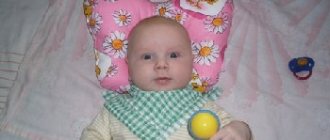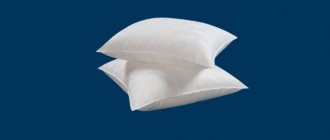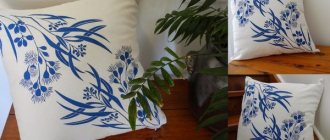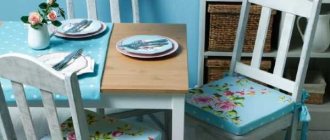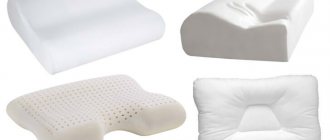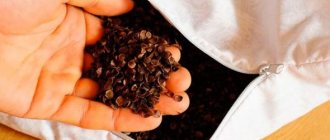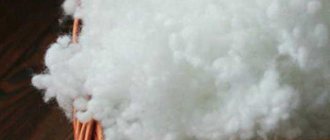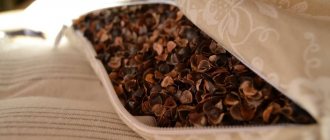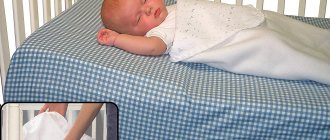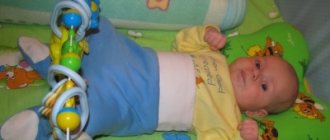The rules for selecting bedding with an orthopedic effect are determined by the structural features of the human spine. In its natural position, it has a curved shape, with the greater bend occurring at the cervical region. In an upright position, the muscles are responsible for the correct support of the spinal column, but in sleep all the muscles are relaxed, so the cervical spine may require additional support.
At what age does a child need a pillow?
A child sleeps 15-18 hours a day for up to six months, so the load during this period falls on the baby’s head, neck and back.
In the last 5 years, manufacturers have begun to offer special orthopedic products for newborns, namely, pillows, claiming that they help the correct formation of the child’s musculoskeletal system and even protect the baby from aspiration (suffocation). Of course, the new products have become mega-popular. However, let's figure out whether such a pillow is recommended for every baby? And do newborns really need it? The issue causes controversy among pediatricians, orthopedists, parents and grandmothers. Doctors say that it is definitely not necessary for healthy children. Many generations of children grew up healthy without special devices, and modern babies are no different from them. The curves of the spinal column are formed gradually; the child does not need unnecessary tension in the cervical region. But some common diseases of infants require a special approach, for example torticollis. A consultation with a pediatrician and orthopedist will help determine whether or not to buy an orthopedic product to support the child’s head.
Head and neck of a newborn baby
Immediately after birth, the cervical spine has no bends. The newborn's neck is short and straight. The curvature of the cervical vertebrae - lordosis - begins to form only at 2-3 months, when the baby begins to raise his head.
The bones of the skull of a small child remain plastic until the fontanelles close. This occurs at 12-24 months. Even after two years, the baby’s head is not a solid bone, but a whole “set” of small bones connected by cartilage.
Common pathologies of newborns
Childbirth is a test not only for the mother, but also for the child himself. Both natural childbirth and surgical childbirth come with many risks. The baby's health can be affected by hypoxia, birth injuries, and hemorrhages. Among the common consequences of “difficult” childbirth, we highlight:
- Torticollis of newborns. The pathological and persistent tilt of the child's head to one side is associated with a number of reasons. If the problem is a temporary asymmetry of muscle tone, the prognosis is more favorable. True muscular torticollis - a consequence of hemorrhage into the thickness of the neck muscle - is more difficult to treat and sometimes requires surgical correction.
- Head deformation. Sometimes damage to the skull bones occurs during childbirth. Even slight asymmetry in head roundness can progress over time. Less commonly, changes in the skull are caused genetically.
- Hypertonicity. Minor hemorrhages into the nervous tissue or brain hypoxia adversely affect the regulation of muscle tone. This, in turn, can lead to deformations of the limbs, torso, and head.
What is the difference between a regular pillow and an orthopedic pillow for infants?
- An ordinary children's pillow is made from fillers that are used in the production of adult analogues: down, feathers, wool, synthetic padding. Orthopedic materials are used in hypoallergenic materials with high elasticity and good ventilation.
- An orthopedic pillow for infants has a shape and size that takes into account the characteristics of the child’s body and the structure of the spine.
- The materials of the cover are hypoallergenic and soft to the touch.
- The cover itself is removable and washable.
Tips for choosing depending on your sleeping position
When choosing an orthopedic pillow, it is not enough to consider only the position in which you fall asleep. Observe yourself for a few days to understand exactly how you greet the morning. The correct choice of orthopedic product largely depends on this.
| Correct pillow firmness | ||||
| What position do you fall asleep in? | What position do you wake up in? | Shoulder width | ||
| 9-12 cm | 13-17 cm | more than 18 cm | ||
| On the back | On the back | Low pillow | Middle pillow | Middle pillow |
| On the stomach | Low pillow | Middle pillow | Middle pillow | |
| On the side | Low/Medium | Medium/High | Medium/High | |
| On the stomach | On the back | Low pillow | Middle pillow | Middle pillow |
| On the stomach | Low pillow | Middle pillow | Middle pillow | |
| On the side | Low/Medium | Medium/High | Medium/High | |
| On the side | On the back | Low/Medium | Middle pillow | High pillow |
| On the stomach | Low/Medium | Middle pillow | High pillow | |
| On the side | Middle pillow | High pillow | High pillow | |
Neurologists recommend high pillows to their patients if an ultrasound examination shows impaired venous outflow or increased intracranial pressure.
Contraindications for using a pillow for babies
In 70% of cases, an orthopedic pillow causes more harm than good. As mentioned above, its use should be agreed with a doctor. Such a product hinders movement, limiting the mobility of a child’s head during sleep, and this is fraught with negative consequences. There are two main contraindications to the use of orthopedic pillows for newborns:
- The baby is prone to frequent regurgitation
- The baby has problems with the respiratory system
Don’t be fooled by advertising gimmicks; head pillows will not solve the problem of suffocation with vomit.
It is recommended to purchase a pillow if:
- The presence of a birth injury with damage to the cervical vertebrae;
- Incorrect formation of the skull shape;
- As an aid to decreased neck muscle tone or, conversely, hypertonicity;
- To prevent the head from turning in the same direction;
- For the treatment of congenital torticollis;
- To eliminate deformation in the early stages of rickets.
Be sure to discuss any ambiguous issues with your child’s attending physician.
In most cases, in the cases described above, a butterfly pillow for newborns is used. How to use it to get a positive effect? How to properly place a pillow under your head? Let us explain: we place a smaller cushion under the baby’s neck when lying on his back, and the second cushion is useful when he sleeps on his side. The head is in the recess in the middle. As the child’s growth increases, it is possible to switch to a large cushion for falling asleep on the back; this does not contradict the indications and rules, since the pillow is designed for children under 2 years of age.
A child will only need a standard children's orthopedic pillow from the age of one and a half to two years, when, looking at his parents, he will want to imitate everything you do and how. By this time, the formation of the main curves of the spine will have ended, the shoulders will become wider, and support for the cervical spine will be required during sleep and rest.
We remind you that the priority when choosing a pillow in this case will be size, materials (including filling), and only then shape, color, and so on.
Types of orthopedic pillows
The wide range of modern pillows makes it difficult for parents to choose. To systematize the information, we will describe the existing models of pillows for newborns.
- The most common is the orthopedic butterfly pillow . This is a small roller with a recessed part in the center. It fixes the baby's head, helping the correct formation of the skull and cervical curve. You can use a butterfly pillow from the 2nd month on the recommendation of a specialist.
- A positioner pillow – although it is called a “pillow”, it is not one. This is a flat product with 2 bolsters on the sides, which allow you to fix the baby’s body in a “sideways” position. The model is recommended for children with a tendency to regurgitate. It will be useful in the first 3-4 months of a child’s life.
- The third type is an inclined pillow . It is made wide, of small height and with a slope of 15 degrees. The product is used to support the baby’s torso in an elevated position; compliance with the width of the crib is its main criterion.
- The next model is called a ring pillow , but it is not placed under the head. It is used during breastfeeding and is a good helper for the mother. Having settled the baby in the pillow, she frees her hands and can take a comfortable position.
A little more about the filler...
Latex
In addition to the material with the “shape memory” effect (options for the name of this material are anatomical foam with the “memory” effect, viscolatex, “memoryfoam”), there are other fillers for anatomical pillows. For example, latex. Latex pillows are quite elastic, they seem to “spring”. They will appeal to back sleepers and those who prefer high pillows.
Latex mini springs
Another variation of latex pillows is pillows with latex mini-springs. They are also quite elastic and hold their shape well, they are hypoallergenic and breathable. From the collection of anatomical pillows from the Ascona factory, this is the Mediflex Revolution pillow.
Independent mini springs
Among elastic models, pillows based on independent mini-springs have a good anatomical effect. For clarity, pay attention to the Mediflex Spring Pillow. It contains mini-springs that are unusually sensitive to load, while perfectly restoring shape. They respond to your movements, providing excellent support. These pillows are recommended when sleeping in any position.
Gel is an innovative material
Another unique material that is gaining increasing popularity is gel with a cooling effect. It distributes the load, has a micro-massage and cooling effect thanks to a special 3D liquid deformation technology. In the Askona collection of anatomical pillows, these are Technogel pillows. Among them there are models with classic shapes, suitable for sleeping on the back, as well as specially shaped pillows, ideal for sleeping on the side and stomach. Not everyone immediately likes gel-based pillows: some people get used to them within a few weeks. But after this, they will not exchange their favorite anatomical pillow for anything!
Pillows with adjustable filling
Another interesting pillow option was offered by Protect-A-Bed: a pillow with a protective pillowcase made of eucalyptus fibers. Its peculiarity is that you can adjust the filler level yourself! Great, right? This pillow is very elastic and “breathable”: you seem to float when you lie on it. So say the happy owners of the Protect-A-Bed pillow. As you can see, today the market can offer you a huge variety of anatomical pillows.
Features of care
The issue of using pillows for a crib cannot be considered settled unless you learn how to care for such products. So:
- Orthopedic pillows made from natural plant materials - buckwheat, coconut coir, etc. cannot be washed.
- Latex, memory, bamboo fiber can be washed by hand or in a machine on a delicate cycle, at a water temperature not exceeding 40 C.
- When washing, use non-aggressive and hypoallergenic products.
- The spin mode is minimal; the pillow cannot be twisted.
- Such a product should be dried horizontally, in the shade.
What should the height of the product be?
The thickness of the model is another important parameter. The price of the correct answer to the question of how to choose the height of an orthopedic pillow is absolute comfort, correct support and, as a result, a healthy spine, so this indicator must be approached with the utmost seriousness.
Today, the height of an orthopedic product ranges from 6-16 cm, but selection must be made individually in each case. To do this, measure the distance from the edge of the shoulder, its most protruding part, to the base of the neck. In this case, the permissible error in the value may be no more than 1-2 cm.
What is an anatomical pillow?
An anatomical pillow for newborns (also called orthopedic) is a special product made from environmentally friendly, breathable materials, made taking into account all the anatomical features of the newborn’s structure, which helps support the neck in the correct position. This normalizes cervical circulation and reduces muscle tone. But it should be used strictly from a certain age: no earlier than two weeks from the day of birth, and in some cases only after 4 weeks - from the 28th day of life.
How to make it yourself
A high-quality orthopedic head pad is not cheap. And those that are sold at a reduced price quickly lose their shape and become unusable. A way out of the situation may be to sew a pillow yourself.
What you need to prepare
Making a butterfly pillow yourself is a little more difficult than a classic bedding product, but it is quite possible. To do this you need to take:
- A large sheet of paper for a pattern.
- Sintepon, which will serve as a filler.
- Cotton, for pillowcase.
- Threads.
- Stationery.
- Needle and pins.
First of all, you should start making the pattern.
Pattern
The pattern is made on a large and fairly thick sheet of paper.
Algorithm:
- Draw a vertical line (length 22.5 cm).
- From the bottom edge of the line, draw a perpendicular line to the right (13.5 cm).
- Do a similar manipulation from the top edge of the line (15 cm).
- Connect the ends of the bases.
- First step back 4 cm from the bottom point of the vertical line, and 6 cm from the top.
- Draw a circle in the center (r-3.5 cm).
- From the first line, step back 1.5 cm at the bottom and top.
- Smoothly connect the resulting points so that the lines resemble the wings of a butterfly.
- Cut out the pattern along the contour lines.
When cutting fabric according to the pattern, you need to add 1-1.5 cm to it on all sides for seams.
Manufacturing
Once the pattern is ready, you can start cutting. To do this, you first need to attach a folded padding polyester to the part, and then cotton, so that their fold coincides with the center of the circle. Next, you need to fold the parts in pairs and sweep them away.
The final stage of manufacturing consists of the following steps:
- Fold the resulting blanks with the right sides of the fabric facing each other and sew them along almost the entire contour.
- While sewing, leave a 4-5 cm section at the top of the product.
- Turn the pillow inside out and iron it gently.
- Fill the wings with padding polyester or latex to make them fuller.
- Sew up the previously left area.
When filling the wings, it is important to remember the unique structure of the orthopedic product. So, the upper part should be noticeably larger than the lower part.
Reviews
Natalya: “I purchased an anatomical pillow for my son already at the 3rd month of his life on the recommendation of an orthopedist. The reason for this purchase was the diagnosis: “Installation torticollis.” For 3 months, my son slept on a pillow for 6-8 hours a day, which had a positive effect on his neck. She has become noticeably straighter, her head is no longer tilted so much to one side, and the child has become calmer.”
Svetlana: “My daughter was born with a crooked head, at first everyone reassured me that this was normal and everything would go away on its own. But by 3 months everything only got worse, then the doctor recommended that I buy a butterfly pillow, which is orthopedic and helps solve problems with skull deformation. Now my daughter’s head has become noticeably straighter, although there are still some defects.”
Inna: “I gave birth to a child at 7 months, which affected his health. Mild muscular dystonia is the diagnosis with which we left the maternity hospital. Now everything is fine, but then the positioner pillow helped us a lot. She prevented my child from bending unnaturally, protecting his spine from curvature. The main thing is to choose a quality product that can be washed frequently without compromising its effectiveness.”
A pillow is a bedding accessory that is not required for a child under 2 years old, provided that he is absolutely healthy and developing normally.
However, if there are a number of diagnoses, you cannot do without it. Modern stores offer many options for children's orthopedic accessories, which differ not only in shape, but also in purpose. The main thing is to choose the one that is most suitable for a particular baby, depending on his state of health. Share?
How and when to use a pillow
An anatomical pillow can be used no earlier than 2 weeks of life - all pediatricians are unanimous on this. But some of them believe that its use can only be started from 28 days of life, while others believe that from 3 months of age. Therefore, it is best to decide whether to use a corrective pillow or not with a pediatrician and only after identifying the individual characteristics of the child’s structure and behavior.
The product should be placed directly under the baby's neck with a narrow cushion. It is best to wash weekly with special anti-allergenic detergents at temperatures up to 40 degrees. You should squeeze it with gentle movements, do not twist it, but dry it in a natural position.
Do you need a changing chest for a newborn? How to properly swaddle a newborn, read here
How can you treat the navel of a newborn baby? Details at the link
Anatomical pillow for newborns: Reviews from parents
Mila Yarovetskaya 22 years old, Khimki. The pillow helped my baby develop a beautiful head shape. I was very worried that he kept turning it to the right in his sleep, which is why the right half of his head became flat. We immediately bought such a pillow, and the result is simply obvious! I laid my son’s head on the left side, and he seemed unwilling and unable to turn it to the right. Therefore, I recommend it to everyone who has such a problem Natalya Serova, 26 years old, Khabarovsk. Very cool thing. We had one like this - with a hole inside. A very convenient thing. Everyone who objects to such a pillow simply doesn’t even understand what they’re talking about.
Anna Petrotskaya 20 years old, Stavropol . My daughter was uncomfortable all the time. She couldn't even sleep, so we refused. Maybe it is needed by those who have some problems. But we slept safely all year on the mattress and everything was fine.
Svetlana Mikhailenko 31 years old, Kaliningrad . This pillow is not needed at all. If the baby spits up. My Artem constantly burped for the first six months, we suffered a lot. How can you fix his head, what if he chokes and suffocates? No. Our mothers raised us without all these innovations, so we will abstain.
Lyudmila Efremova 29 years old, Moscow . The pediatrician advised us to take such a pillow and our son slept on it with pleasure. So thin and elastic in the shape of a heart. No problems with neck or head support
Victoria Svetlichenko 36 years old, Rostov-on-Don . The first child slept traditionally on a pillowcase, no problems, but for the second they decided to buy one. The head was like an egg, very ugly. The pad leveled everything!
